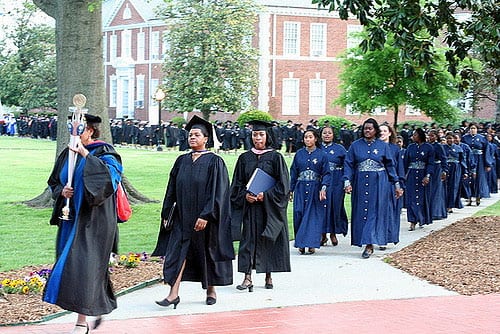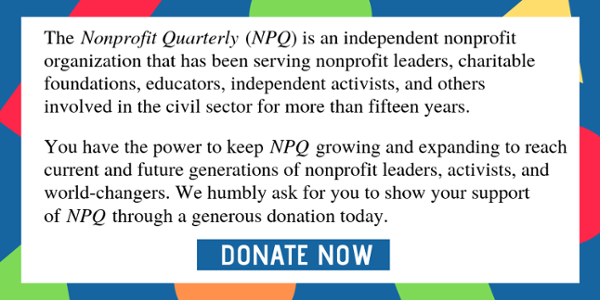
December 17, 2018; The Root
Both Spelman College and Bennett College—the nation’s sole all-female historically black colleges and universities (HBCUs)—made headlines this past week. Spelman was gifted $30 million, one of the largest donations ever made to an HBCU, from trustee Ronda Stryker and her husband William Johnston to help build a new Center for Innovation and the Arts. In contrast, Bennett College was informed that its accreditation—essential for accepting federal funds that cover tuition and fees—would be revoked because of financial shortfalls.
Financial struggles are nothing new for HBCUs, with at least six closing since 1988. The 18 historically black public land grant institutions (e.g., North Carolina A&T and Tuskegee) have historically received unequal funding from their states compared to their white land grant counterparts and struggled (mostly unsuccessfully) to make the required 100 percent match for full federal funding.
HBCUs also wrestle with the financial impacts of declining enrollments since higher education desegregation, as well as from the personal financial challenges of their students. Fifty years ago, 90 percent of all black college students went to HBCUs. Today, 90 percent of black students attend mostly white schools. Between 2010 and 2015, 20 black colleges saw enrollment plunge by more than 25 percent. HBCUs also struggle with significantly lower graduation and retention rates than their white counterparts. While the six-year graduation rate for all US colleges is 59 percent, more than half of HBCUs graduate fewer than 30 percent of their students within the same time period. These low graduation and retention rates are clearly linked to students’ economic status: while about one-third of all college students come from families that qualify for the federal Pell Grant, two-thirds of HBCU students are from Pell families.
HBCUs also have significantly fewer financial assets than their white counterparts. Highly ranked Spelman College with 2,137 students has an endowment of $366 million, a per capita financial base of $171, 268. Wellesley College in Massachusetts, also one of the nation’s most highly regarded liberal arts colleges for women, has 2,350 students but boasts an endowment of nearly $2 billion (a per-capita base of $851,063), about five times that of Spelman’s.
Despite these challenges, a recent Gallup study concludes that black HBCU graduates are more likely than black graduates of other institutions to thrive in several areas, specifically when it comes to their finances and sense of purpose. Forty percent of black HBCU grads are effectively managing their economic lives to reduce stress and increase security compared to 29 percent of black grads from other schools.
Sign up for our free newsletters
Subscribe to NPQ's newsletters to have our top stories delivered directly to your inbox.
By signing up, you agree to our privacy policy and terms of use, and to receive messages from NPQ and our partners.
Clearly, black colleges and universities are not monolithic. Some, like Spelman, are strong academically and financially, with well-heeled trustees and supporters. Trustee Ronda Stryker, who with her husband made the $30 million gift, is the heiress of a Fortune 500 medical technologies firm founded by her grandfather. Here’s how she explains why she joined the Spelman board in 1997:
I have always known that when a woman receives a college degree, the entire family and future generations of that family benefit directly. Higher education for women, women of color, non-traditional women students and women returning to education after raising families has held high importance in my gifts of time, talent and treasure.
But for colleges like Bennett, the last decade has been extraordinarily difficult. Battered by the recession, HBCUs were disproportionately affected by a 2011 change to the PLUS federal student loan program that imposed stricter lending guidelines. And with an endowment of only $13 million, Bennett’s cushion is thin. The college’s 2010 enrollment of 714 dropped to 469 this school year. Though last year’s fundraising efforts succeeded in generating more than $4.2 million in gifts and pledges, that campaign was not successful in persuading the accrediting agency to take the college off its probationary status.
What do these two very different stories mean about the future of HBCUs, particularly for small liberal arts institutions? Will the weak go down and the strong survive, as former Morehouse College President and current Harvard Trustee John Wilson prophesizes? “Just as the women-only college sector right-sized from over 300 about 50 years ago to roughly 42 now, I believe the HBCU sector will shrink or right-size within the next decade.”
Former Winston-Salem State University chancellor Alvin Schexnider urges struggling HBCUs to carefully assess their situation, that “not failure, but low aim is the sin.” In addition to taking a hard look at reality, he asserts that black colleges “desperately” need a new business model, confronting “an organizational culture rooted in obsolete business practices and/or identifying a niche or center of excellence.” They must create a new vision, partnering with 2- and 4-year institutions to contain costs and create joint-degree programs. And they must have strong boards that can recruit the best presidents and include faculty, staff, students and alumni in meaningful leadership and governance roles. “Money is necessary but not sufficient to remedy the ailments of HBCUs.”
In sum, HBCUs must do what any nonprofit must do if it is to be sustainable in our dynamic and challenging world. But an equity lens demands that we do more to sustain these critical American institutions and acknowledge their place not just in our past, but our future.—Debby Warren














